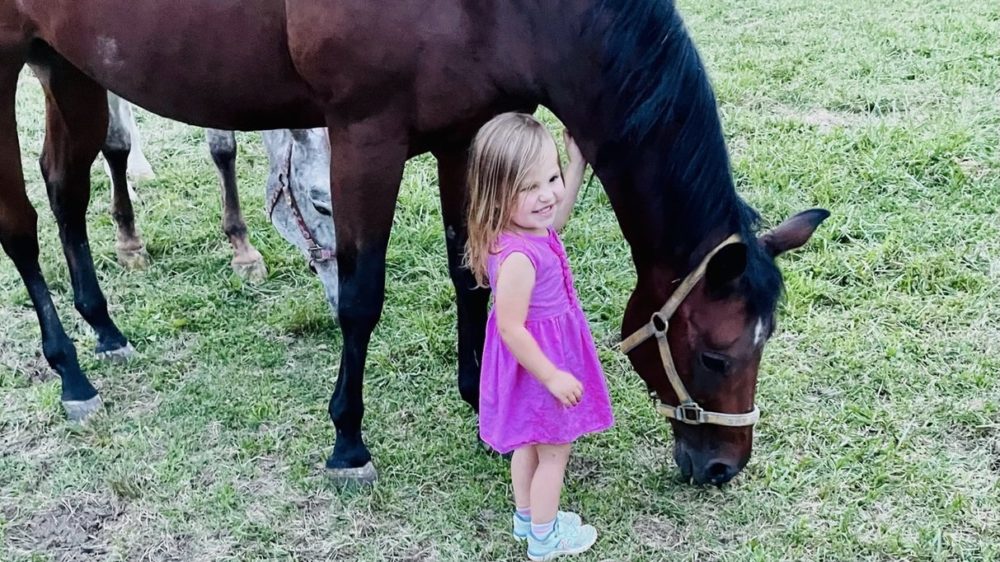Early childhood educators and coaches are relatively consistent across the board in believing that participation in sports as a child is critical for developing motor and social skills that carry them successfully into adulthood. Additionally, the younger a child begins an activity, the more time they will inevitably have to practice and improve throughout their life.
Horses are no exception, and many youth riders, parents, and trainers believe it is a great advantage for children to begin riding when they are young – particularly if they end up showing and competing as they get older. But the adage still applies…practice is only valid where it reinforces positive habits: perfect practice makes perfect.
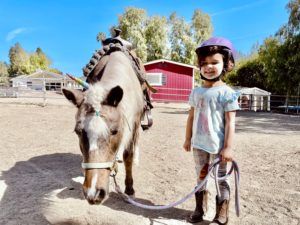 Often, it can be logistically tricky (due to travel or expense) or even impossible to begin lessons for children at an early age. Many insurance companies won’t even insure barns for providing lessons to children under certain ages.
Often, it can be logistically tricky (due to travel or expense) or even impossible to begin lessons for children at an early age. Many insurance companies won’t even insure barns for providing lessons to children under certain ages.
Therefore, we decided to ask some industry experts for essential pointers on teaching young kids how to ride before they begin taking lessons under the tutelage of a professional trainer – whether these early lessons be at home or with a local, smaller-scale barn.
Our experts Tom McBeath (Tom McBeath Quarter Horses), Lynne Puthoff (Puthoff Performance Horses), and Melissa Shetler (Circle M Training Center) emphasized the following five tips for providing the proper riding foundation for children ages 3 to 6 at home.
Safety First
Our experts consistently stated that safety is the number one priority when teaching young children to ride. Specifically, they agreed that the horse can often make or break a young rider’s desire to continue with horses. Therefore, a safe mount (whether that be a retired show horse or a child-safe pony) is critical to the success of teaching a toddler how to ride.
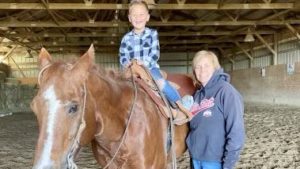 They all recommended choosing a tolerant animal with more whoa than go that is relatively predictable and manageable. If this is not available, then it’s best to avoid exposure to horses at that time.
They all recommended choosing a tolerant animal with more whoa than go that is relatively predictable and manageable. If this is not available, then it’s best to avoid exposure to horses at that time.
Once you’ve found your child-safe mount, Puthoff recommends keeping the horse and child in a smaller, confined area when you begin, so that the horse can’t get away from you. For example, she recommends riding in a small paddock or round pen in the beginning.
If a confined space is not available, Puthoff recommends keeping the horse on a lead rope or longe line at all times so that you can get control of the animal if and when necessary.
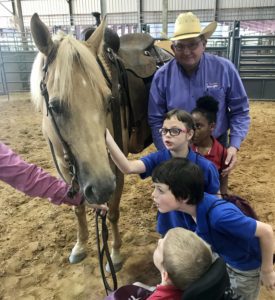 McBeath agrees that it is best to keep a young child on a lead (or hold them in front of your saddle while riding a broke horse around). Additionally, he emphasizes the importance of proper safety equipment from the beginning. For example, it is not enough just to have your child wear a helmet – the helmet must also fit properly.
McBeath agrees that it is best to keep a young child on a lead (or hold them in front of your saddle while riding a broke horse around). Additionally, he emphasizes the importance of proper safety equipment from the beginning. For example, it is not enough just to have your child wear a helmet – the helmet must also fit properly.
If the child is riding in a saddle and not bareback, a proper fitting saddle that doesn’tt pinch the legs with appropriate stirrups is essential. Children should also wear closed-toe shoes (preferably boots) and pants when at the barn.
Shetler reminds us that, even though they are young, it is vital to explain the consequences of standing in the wrong spot, like getting kicked or stepped on. She finds kids tend to follow safety instructions better when you link consequences to the rule.
Keep It Short and Simple
Parents, mainly those knowledgeable about horses, can fall into the trap of teaching a young child too much about the process, which can be overwhelming for little ones. Our experts emphasized the importance of keeping the lessons simple and to the point.
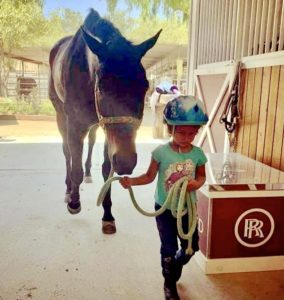 Puthoff said that similar goals are necessary with young riders and young horses – you don’t want to expect too much initially.
Puthoff said that similar goals are necessary with young riders and young horses – you don’t want to expect too much initially.
Instead, focus on small, short-term goals and praise your child for their little victories. The point of starting a rider young is to encourage them into the sport. If you set high expectations from the beginning, both you and your child will likely end up feeling discouraged.
McBeath adds that little ones have short attention spans, and sometimes an excellent lesson for their age group is only 10-15 minutes long. This way, you can focus on making the lesson fun without belaboring an issue. He reminds parents that if you try to teach your kid too much too soon, you are more likely to teach them a bad habit that a trainer will eventually have to undo.
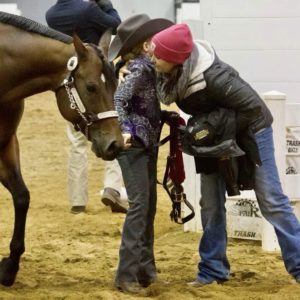 Shetler gives lessons to several four-year-olds, making it a point to keep lessons around 20-30 minutes long, including basic groundwork. She wants to set the kids up to have fun, so they aren’t overstimulated or feel like riding is a chore.
Shetler gives lessons to several four-year-olds, making it a point to keep lessons around 20-30 minutes long, including basic groundwork. She wants to set the kids up to have fun, so they aren’t overstimulated or feel like riding is a chore.
Unfortunately, this may also mean ending a lesson when the child is not in the mood to listen or continue because it is more important to set up a positive experience than drill in a practice session.
Have the Right Focus
The goal of any riding lessons for young children should not be to ride at the Congress, but to teach them a basic comfort level around horses. After that, they may desire to continue with the sport and eventually get involved with professional lessons when they are old enough.
McBeath recommends letting kids be involved in primary care, like brushing and feeding a horse. Horses are large animals for adults to manage, but they are gigantic for small children. This size differential alone can be intimidating, so setting kids up to enjoy their time around the animals is crucial.
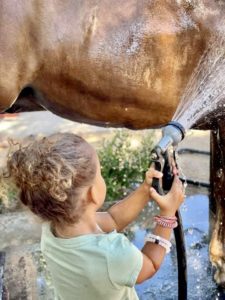 A safe horse is the first step to a positive experience, but letting the child participate and come along at their own pace can be the best way to encourage them around horses.
A safe horse is the first step to a positive experience, but letting the child participate and come along at their own pace can be the best way to encourage them around horses.
McBeath emphasized that you do not want to fear horses based on a bad experience, so making every interaction as positive as possible is critical. The background should build confidence and comfort around horses, not on winning a horsemanship class.
Shetler agrees that riding at a young age should not be about perfection and technique, but simply about learning to be safe and stay on the horse.
While it can be tempting for parents to want to see their young child going around the arena, Shetler believes the focus should be more on having fun and enjoying the animals than preparing them for a competition that won’t take place for years.
Teach the Basics
There are many different riding and training styles out there. All of our experts believe that parents who desire that their child have a future with a trainer should focus on the fundamental ideas in the beginning. It is important not to confuse them or contradict what their future trainer will teach them.
 Puthoff recommends parents focus on teaching children how to lead a horse (the proper place to stand and how to hold the rope without getting tangled); brush a horse’s body (and how to be mindful of their legs/feet); the basics of steering a horse (keeping the animal between the reins); and, perhaps most importantly, how to stop (whoa means whoa).
Puthoff recommends parents focus on teaching children how to lead a horse (the proper place to stand and how to hold the rope without getting tangled); brush a horse’s body (and how to be mindful of their legs/feet); the basics of steering a horse (keeping the animal between the reins); and, perhaps most importantly, how to stop (whoa means whoa).
Shetler likes parents to help children learn how to use their bodies as a rider – how to sit up straight, look forward, and balance the horse’s back with their weight in their butt and legs over the center of the horse.
Sometimes, the best teachers for improving balance are horses that, while broke, aren’t the smoothest ride. A bouncy pony can be the best teacher for the skills necessary to learn how to sit the trot properly.
Shetler has found, as a trainer, you can’t teach feel. However, the kids who start riding younger tend to have a better balance and feel like older youth riders.
Practice Coachability
Being a student is one of the most valuable attributes a parent can teach a child to prepare them for professional lessons.
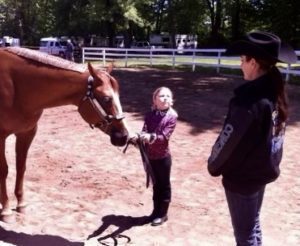 Shetler believes that teaching your child to respond appropriately to a coach and to be willing to learn, are valuable lessons for all walks of life. Still, it is crucial for safety purposes around horses.
Shetler believes that teaching your child to respond appropriately to a coach and to be willing to learn, are valuable lessons for all walks of life. Still, it is crucial for safety purposes around horses.
If a child cannot listen to basic instructions, it can quickly amplify the danger of working with horses. When asked, kids need to avoid certain animals, stop their horse when told, and follow basic instructions for cueing and caring for the animals.
McBeath says that a child who is ready and able to learn is the best student. Teaching a child to listen, ask questions if they are confused by instructions, and follow instructions, are necessary for their safety at any training barn at any age.
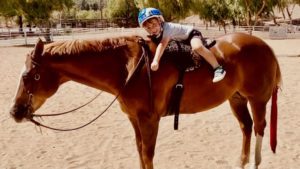 Teaching your child obedience, critical listening skills, and the confidence to speak up when needed will set them up for good relationships with their future coach. He believes that coachable youth riders are set up for great careers as riders and as human beings in general.
Teaching your child obedience, critical listening skills, and the confidence to speak up when needed will set them up for good relationships with their future coach. He believes that coachable youth riders are set up for great careers as riders and as human beings in general.
***
Teaching your child to love and respect horses at a young age is a valuable lesson and should be a fun experience for parents and children alike. However, our experts are clear that if you cannot set up a positive experience that focuses on safety, the basics of horsemanship, and is limited in scope, you are better off waiting for when your child is old enough for professional lessons.


